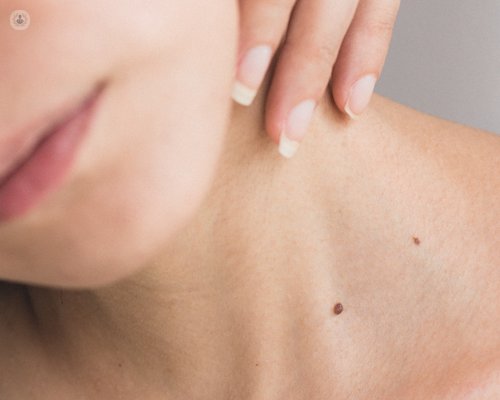Skin tag removal: What to expect
Written in association with:Considering getting a skin tag removed? Do you have questions about this minor operation? Leading private GP Dr Andrew Burgess can help. He goes into expert detail into the skin tag removal procedure in this informative article.

What are skin tags, and why do they develop?
Skin tags are small, benign growths that commonly appear on areas of the body where skin rubs against skin or clothing. They are typically painless and harmless, although they can sometimes cause irritation or discomfort if they catch on clothing or jewellery.
When is skin tag removal recommended?
Skin tag removal is usually recommended for cosmetic reasons or if the tags are causing discomfort due to their location or size. While skin tags are generally harmless, removal may be necessary if they become irritated, bleed, or if there is suspicion of a more serious condition.
What are the different methods of skin tag removal?
Excision
Excision involves cutting the skin tag off with a scalpel or scissors after numbing the area with a local anaesthetic. This method is effective for larger skin tags or those located in sensitive areas.
Cryotherapy
Cryotherapy involves freezing the skin tag with liquid nitrogen, causing it to fall off over time. This method is suitable for smaller tags and may require multiple treatments for complete removal.
Ligation
Ligation involves tying off the base of the skin tag with a suture or string, cutting off its blood supply and causing it to eventually fall off. This method is less commonly used but may be appropriate for larger tags.
What can patients expect during a skin tag removal procedure?
Consultation
Before the procedure, patients will have a consultation with their healthcare provider to discuss the best method of removal and any potential risks or complications.
Procedure
During the procedure, the area around the skin tag will be cleaned, and a local anaesthetic may be applied to numb the area. The chosen removal method will then be performed, and the skin tag will be removed.
Aftercare
After the procedure, patients may experience mild discomfort or redness at the removal site. They will be advised to keep the area clean and dry and to avoid picking at or irritating the area.
What are the potential risks and complications of skin tag removal?
While skin tag removal is generally safe, there are some risks and potential complications to be aware of, including:
- Bleeding: Some bleeding may occur during or after the procedure, especially with excision.
- Infection: There is a risk of infection at the removal site, particularly if proper aftercare instructions are not followed.
- Scarring: In some cases, scarring may occur at the removal site, especially with excision or if the area is not properly cared for post-procedure.
What is the recovery time after skin tag removal?
Recovery time varies depending on the method of removal and the individual's healing process. In general, most patients can expect the area to heal within a few days to a couple of weeks. It is essential to follow any post-procedure instructions provided by the healthcare provider to promote proper healing and minimise the risk of complications.
Skin tag removal is a common and relatively simple procedure that can improve both physical comfort and self-confidence. By understanding the different removal methods, potential risks, and aftercare requirements, patients can make informed decisions about their skin health and well-being. If you have concerns about skin tags or are considering removal, consult with your healthcare provider for personalised advice and treatment options.
If you’d like a consultation regarding skin tag removal with Dr Burgess, arrange a consultation via his Top Doctors profile.


